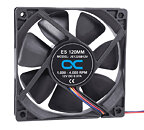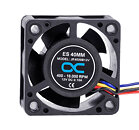Thursday, February 11th 2021

Alphacool Introduces Three New Enterprise Solutions Fans
The Alphacool ES fans have been specially developed for use in servers and workstations and, unlike usual, do not offer a 2 or 3-pin DC power connection, but a 4-pin PWM control. Via the 4-pin PWM connector, the fan always receives full voltage and is controlled by pulse width modulation. This allows the fan to be controlled over a much wider speed range. A considerable amount of energy can be saved whilst controlling the fans in server racks and with 0% PWM control, the fans can even be stopped completely.
Unlike classic plain bearing, Alphacool ES fans have a double ball bearing for increased service life under full load. Double ball bearings are generally regarded as the highest quality bearings in terms of durability and quality. All Alphacool Enterprise fans have multiple protection circuits. If the fans are blocked, they automatically try to restart at reduced speed after a few seconds. Thanks to the soft start, including the emergency start function, the fan can be blocked for up to 72 hours without suffering damage.Safety Features
Unlike classic plain bearing, Alphacool ES fans have a double ball bearing for increased service life under full load. Double ball bearings are generally regarded as the highest quality bearings in terms of durability and quality. All Alphacool Enterprise fans have multiple protection circuits. If the fans are blocked, they automatically try to restart at reduced speed after a few seconds. Thanks to the soft start, including the emergency start function, the fan can be blocked for up to 72 hours without suffering damage.Safety Features
- Automatic Shutdown: Automatic switch-off if the fan is blocked
- Automatic restarting: Restart attempt after 2-6 seconds if blocked
- Damage due to blocking: It is guaranteed that the fan will not be damaged if it is blocked for up to 72 hours








7 Comments on Alphacool Introduces Three New Enterprise Solutions Fans
10/15k on a 40mm fan... what a couple of screamers... glad they're made for industrial uses :D
A regular radiator on an open testbench and a flow-measurement tunnel with no significant impedance will always paint a thicker, pressure-focused fan in poor light. Where they shine is in a more common scenario that is rarely tested for, the quiet PC.
We're talking indirect air-path from side baffles around the edges, through restrictive vents, baffles, past a wall of sound-absorbtion foam, through a dust filter, through a dense radiator, and into a case with positive pressure and indirect exhaust.
So yeah, 38mm fans aren't universally better, they're just misunderstood by many reviewers - or at least not ideally suited to the common mainstream cooling applications that most fans are benchmarked against. There's a reason that the server world uses them instead of 25mm fans, and that's because airflow impedance in servers vastly exceeds anything you'll see in mainstream PC cases. Once you hit a certain threshold of airflow restriction, the depth of the fan, and the resulting increase in the blades' ability to compress air smoothly, plays are far more important role.
It's easy to get sidetracked by all-glass vanity builds that are pushed to the front by marketing, sponsorship, and streamers, but the low-flow, sound-absorbing cases are still popular and common, despite not being glamourous enough to win airtime in the spotlight. If you're an adult who just dumps their PC under a desk and wants it to be unobtrusive, this is the market for you, and I'm willing to bet that it's a much bigger market than the RGBLED tempered glass company marketing departments want you to believe.
Yeah 40-40 is pretty dinky fan and really has no fins lol
Smallest I have for rigging over memory is 60x noctua 3k+- rpm nf-a6x25 19.3 dba 13.7 with adapter.
There are decent 38mm consumer fans, aimed at great noise levels for the given static pressure they generate, Silverstone make some, and 12V 38mm fans from Sanyo, Sunon, Delta exist that are used in other consumer applications where unobtrusive cooling is required, just not PCs. For some reason, PCs are stuck in the 25mm rut that's just a legacy of the '90s.